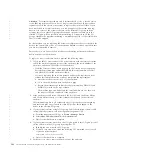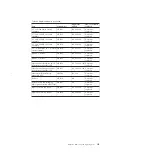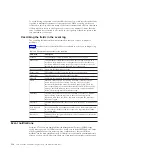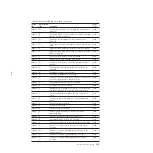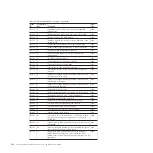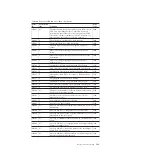
of service actions that are being performed. If a recommended service action is
active, these events are notified only if they are still unfixed when the service
action completes.
Each event that Storwize V7000 detects is assigned a notification type of Error,
Warning, or Information. When you configure notifications, you specify where the
notifications should be sent and which notification types are sent to that recipient.
Table 24 describes the types of event notifications.
Table 24. Notification types
Notification type
Description
Error
An error notification is sent to indicate a problem that must be
corrected as soon as possible.
This notification indicates a serious problem with the Storwize
V7000. For example, the event that is being reported could indicate
a loss of redundancy in the system, and it is possible that another
failure could result in loss of access to data. The most typical reason
that this type of notification is sent is because of a hardware failure,
but some configuration errors or fabric errors also are included in
this notification type. Error notifications can be configured to be
sent as a Call Home email to the IBM Support Center.
Warning
A warning notification is sent to indicate a problem or unexpected
condition with the Storwize V7000. Always immediately investigate
this type of notification to determine the effect that it might have
on your operation, and make any necessary corrections.
A warning notification does not require any replacement parts and
therefore should not require IBM Support Center involvement. The
allocation of notification type Warning does not imply that the
event is less serious than one that has notification type Error.
Information
An informational notification is sent to indicate that an expected
event has occurred: for example, a FlashCopy operation has
completed. No remedial action is required when these notifications
are sent.
Power-on self-test
When you turn on the system, the node canisters perform self-tests.
A series of tests is performed to check the operation of components and some of
the options that have been installed when the units are first turned on. This series
of tests is called the power-on self-test (POST).
If a critical failure is detected during the POST, the software is not loaded and the
fault LED is illuminated. To determine if there is a POST error on a canister, go to
“Procedure: Understanding the system status using the LEDs” on page 49.
When the software is loaded, additional testing takes place, which ensures that all
of the required hardware and software components are installed and functioning
correctly.
Chapter 9. Event reporting
115
Summary of Contents for Storwize V7000
Page 1: ...IBM Storwize V7000 Version 6 3 0 Troubleshooting Recovery and Maintenance Guide GC27 2291 02...
Page 6: ...vi Storwize V7000 Troubleshooting Recovery and Maintenance Guide...
Page 8: ...viii Storwize V7000 Troubleshooting Recovery and Maintenance Guide...
Page 10: ...x Storwize V7000 Troubleshooting Recovery and Maintenance Guide...
Page 34: ...18 Storwize V7000 Troubleshooting Recovery and Maintenance Guide...
Page 42: ...26 Storwize V7000 Troubleshooting Recovery and Maintenance Guide...
Page 80: ...64 Storwize V7000 Troubleshooting Recovery and Maintenance Guide...
Page 128: ...112 Storwize V7000 Troubleshooting Recovery and Maintenance Guide...
Page 156: ...140 Storwize V7000 Troubleshooting Recovery and Maintenance Guide...
Page 166: ...150 Storwize V7000 Troubleshooting Recovery and Maintenance Guide...
Page 171: ......
Page 172: ...Printed in USA GC27 2291 02...


